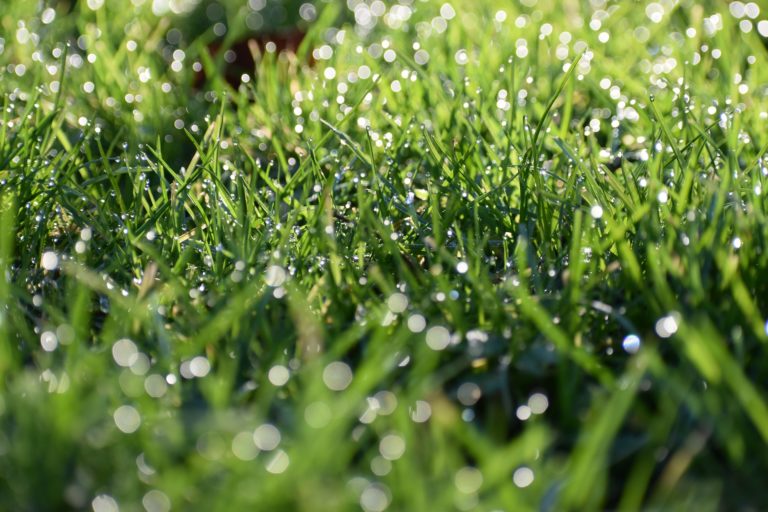Many mowing robots have a rain sensor that tells them when it is raining and sends them back to the charging station. I have often wondered myself whether such a rain sensor is necessary, and have thus done some thorough research on the topic. In this article, I’ll be discussing whether or not robotic mowers actually need a rain sensor.
Does a robotic mower need a rain sensor? Whether a rain sensor is useful for a robotic mower or not depends primarily on its weight. Robotic mowers are weatherproof, so they do not need a sensor to protect them from damage. Rather, the lawn needs protecting: heavy robotic mowers can have problems mowing wet lawns properly, and even damage them.
There are various reasons for or against a rain sensor, but its necessity depends primarily on the model. I will explain everything in more detail down below.
Contents
Good Robotic Mowers Don’t Usually Need a Rain Sensor
As mentioned at the beginning of this article, the rain sensor is intended to prevent the robotic mower from mowing in wet conditions. As soon as it notices that it is raining, it drives back to the charging station. This is not to protect the device – mowing robots have no problem with normal rain – but to protect the lawn from possible damage.
Older robotic mowers are usually heavier than newer models, as they use outdated battery technology and therefore have significantly heavier batteries. Such lawn robots can sometimes reach a weight of 60 lbs or more. With such a heavy weight on moist ground, the lawn ends up flattened, rather than mowed.
In addition, older or less sophisticated models have difficulty cutting the wet grass itself- unlike Husqvarna’s Automowers, for example, which cut wet grass particularly well. There is also the problem that some robotic mowers get louder when they cut wet grass, versus dry grass.
Last but not least, heavy robotic mowers in particular have a tendency to churn up the ground in steep places during wet conditions, thus damaging the turf.
To summarize- older, heavier robotic mower models have the following problems under wet conditions:
- Flattening instead of mowing the lawn
- Difficulties cutting blades of wet grass
- Increased noise level when mowing wet grass
- Damage to the ground and grass in wet conditions due to heavy weight
However, all these are problems that a modern sophisticated robotic mower no longer poses. Current models usually have a light LI battery and weigh no more than 34 lbs.
I would generally advise against buying a robotic mower with an old nickel-metal hydride or even lead-gel battery, as one of the many disadvantages of these batteries is simply that they are too heavy.
Modern Robotic Mowers Can Mow in the Rain
Not only can newer models of robotic robots efficiently and safely mow in the rain, there are also many benefits to mowing the lawn in the rain.
The lawn should be mowed at least 3 to 4 times per week. Especially when it rains a lot, grass grows especially fast, which you must watch out for if you wish to mulch your grass. If too much time passes between mowings, the grass can become very tall and unruly, and when mowed, long grass clippings can cause many problems.
- Long clippings do not compost fast enough
- The lawn becomes matted
- Lawn diseases and molds can spread faster
- The entire lawn suffers and has to be repaired with great effort
Apart from that, it doesn’t look nice if the lawn continues to grow all the time while the mowing robot remains on its charging station because it thinks it is too wet to mow.
You can also damage the lawn by mowing it very short after allowing it to overgrow. A key piece of advice is to follow the one-third rule: avoid cutting off more than the top third of the grass. Not only can mowing off more than one third of the grass at a time be damaging to the grass, it can cause problems for the mower. If you are not careful, your grass may become long enough that the robotic mower cannot cope with it, and you will be forced to mow it by hand with a conventional lawnmower before your mowing robot can be used again.
Taking all this into consideration, most people prefer robotic mowers that don’t need a rain sensor at all, because they are lightweight and their mower deck is optimized so that they can still mow well in the rain. Only heavy, older or less-sophisticated models really need a rain sensor.
However, There Are Also Reasons Not to Mow in the Rain
A few exceptions stand out against mowing in the rain. On one hand, having a lawn with bottlenecks or corners means your robotic mower frequently drives over these areas. If it does so while the lawn is wet, the ground can become agitated and the grass in these areas can become damaged.
If your lawn has particularly steep slopes, both heavy and lighter-weight robotic mowers will have issues traversing them in the rain. On very steep inclines, even lighter models can get their wheels spinning in the wet grass and end up damaging the turf.
And then there’s the problem with leaves. Leaves can also become a problem in wet conditions, as they provide an extremely slippery surface for the robotic mower. So if you generally have a lot of leaves in your yard, especially leaves on top of significant slopes, your robotic mower may not be able to handle the terrain due to wheel spinning or slipping.
Moreover, lawn robots get dirty a slightly faster when they mow in the rain. However, this can depend somewhat on the nature of the lawn. Some mowing robot owners find it annoying to remove dried grass from their mower. For others, though, this doesn’t seem to be such a big deal. The only way left for you to know if you should let your robot out in the rain is to test it. In general, I definitely recommend mowing in the rain if possible.
To make it simple, here are the listed possible reasons for and against a rain sensor:
Reasons for and Against a Rain Sensor
Advantages
- Heavy mowing robots (~60 lbs) can spin their wheels and getting stuck in the rain
- Heavy mowing robots (~60 lbs): press the lawn flat in wet conditions instead of mowing
- Old mowers: High noise level when mowing wet lawns
- Yards with lots of leaves: In wet conditions, wheels can spin or robotic mowers can get stuck here too
- Yard with a steep incline: Heavy robotic mowers, and even some light ones, can go crazy here in the wet grass or slip off and damage the lawn
- The mowing robot pollutes slightly less
Disadvantages
- Mowing the lawn too rarely results in poor composting of the cuttings
- Problems such as matting, diseases and molds can arise
- Uneven lawn cut
- Cutting more than one third of the grass height after not having mowed for awhile is bad for the grass.
- Overall worse lawn appearance
- After long breaks mowing by hand may become necessary
How to Protect Your Lawn from Damage Caused by Mowing in Wet Conditions
Even if you have a yard where it is difficult for the robotic mower to mow in wet conditions, you can still make it work without damaging the lawn or getting your robot stuck.
One such possibility is using so-called lawn protection grids that you can find here on Amazon . This is usually a green grid, which is not particularly noticeable and protects the turf and the soil from damage, wash-out, and erosion. You can easily install such a lawn protection screen in problem areas such as steep slopes, or bottlenecks and corners that are used particularly frequently.
. This is usually a green grid, which is not particularly noticeable and protects the turf and the soil from damage, wash-out, and erosion. You can easily install such a lawn protection screen in problem areas such as steep slopes, or bottlenecks and corners that are used particularly frequently.
There are different types of lawn guards. The thinner ones can also be used on already existing green areas, while thicker lawn protection grids require a complete replanting of the lawn in the appropriate place. However, the thicker version is more likely to be used for cars etc., while the thin version should be sufficient for mowing robots.
If Your Mowing Robot Has a Rain Sensor, You May Need More Area Output
If you choose a robotic mower with a rain sensor, you may need a mowing robot with a larger area mowing capacity. For example, if you choose to have a rain sensor because your yard has a steep slope where the robot would slip or spin its wheels when wet, this means your robotic mower will go out to mow less often. Therefore, when it does go, it must also manage more. Make sure to consider such factors when you are choosing a robotic mower.
With this area output calculator you can calculate how large of an area output you need. You can also indicate whether you have a rain sensor, or how many rainy days on average you can expect in your region.
Feel free to have a look at the robotic mowers that I recommend for different area sizes:
- Recommended Robotic Lawn Mowers for Small Yards 2021
- Recommended Robotic Lawn Mowers for Medium Yards 2021
- Recommended Robotic Lawn Mowers for Large Yards 2021
Related Questions
Can you retrofit your mowing robot with a rain sensor? There is sometimes the potential to retrofit a rain sensor, but these efforts are rather immature and impractical. One idea, for example, is to attach a rain sensor plus switch to the power supply of the charging station. As soon as it rains, the power supply to the charging station is switched off. However, this has two problems:
- If the power supply to the charging station is interrupted, it is possible that the lawn robot will drive out and back in again from time to time because it thinks it is not sitting properly on the charger.
- The battery depletes more quickly if the mowing robot is connected to a switched-off charging station, as it loses charge via the charging contact points.
- If the power supply is interrupted for too long, the mowing robot may have to be reactivated by a PIN.
If you know that there could be problems in your yard when it rains, you should definitely choose a model that has a rain sensor in advance, to avoid such problems.
08/20/2020
Recent Content
Are you looking to buy a robotic lawn mower? I think there has never been a better time, since the most recent models on the market are actually quite sophisticated so that it can now be appealing...
High-end robotic lawnmowers can be a significant investment, so I was curious about how often they get stolen and did some research on the topic. Although there is no specific data available on...

